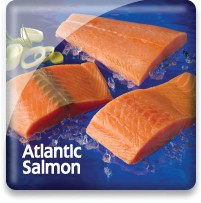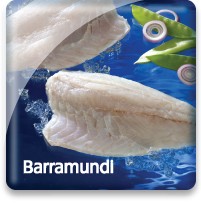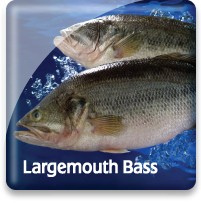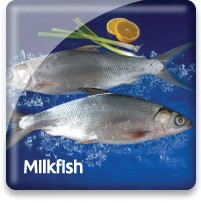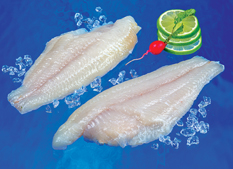
Channel Catfish

Market Name: Eating Qualities
Catfish is a rather versatile fish, that is adaptable to any number of cooking methods. The white fillets have a firm texture and mild to moderate taste, and easily take on flavors that are introduced during cooking. While deep fat frying is most popular, catfish can be baked, broiled, grilled, poached, sautéed,
   |
Description & CharacteristicsChannel Catfish (Ictalurus punctatus) is a native catfish to North America and is often called Forked Tail, Spotted Cat, or River Cats by the local populations.
In the late 1950s, Channel Catfish aquaculture became firmly established in the southern Mississippi River Valley region of the United States. Farming of this native catfish was made possible by advancements in hatcheries, grow out, feed formulations, transportation, and the availability of processing facilities. Today Channel Catfish is the dominant farmed raised fish in United States.
Although channel catfish have poor eyesight, their barbels (whiskers) are well equipped with taste buds that help them find food at night and in muddy waters.
Other Resources |
Handling Instructions for Channel Catfish
Frozen Catfish fillets should be stored at or below 0°F (-18°C) and then thawed properly when ready to cook. The frozen shelf life is 18 months. Links to proper seafood handling instructions: NOAA - Fish Watch: Handling Seafood and A Consumer Guide to Safe Seafood Handling.
Thawing Channel Catfish
Thawing is accomplished by placing the fillets in a sealed plastic container or bag and placing in the refrigerator (33 to 39°F) for 12-24 hours. This is our recommended thawing method for fillets. Fillets that are not consumed promptly after thawing need to be refrigerated between 33 and 39°F and totally consumed within 2-3 days.
Important Instructions for Channel Catfish
Consuming the fillets immediately after proper thawing yields the best quality.
Cooking Tips
Channel fillets can be prepared using a wide variety of cooking techniques. Link to cooking tips and recipes.
China
With more than 1.3 billion people, China is today the world’s most populous country. With a growing economy fueling an appetite for seafood, China has begun importing seafood for in-country consumption, as well as exporting a great deal of its production. In fact, since 2002, China has continued to export more fish and fishery products than any other country in the world, with Japan, the United States, and the Republic of Korea as its main export markets.
Chinese distant water fishing activities started in 1985 when China gained access to new fishing grounds through agreements with foreign countries. China operates vessels in West Africa, the North Pacific, and tuna longline vessels in the South Pacific. In addition, squid are harvested in the Japan Sea, the South Atlantic, and the North Pacific under Chinese-flagged vessels.
Carp are also commercially important, as are bream, shad, eel, catfish, rainbow trout, salmon, mullet, mandarin fish, perch, sturgeon, and murrel (snakehead). Commercial shellfish include Saltwater & freshwater shrimp, river crabs, and mollusks such as mussels, clams, scallops, oysters, and freshwater snails.
With one-fifth of the world’s population, and an official government policy to promote aquaculture, China has today become an aquaculture powerhouse, now producing more than two-thirds of the world’s aquaculture species. Fish and shellfish are grown in freshwater and saltwater environments.
Go Blue! Seafood Sustainability Spectrum*Click here for an explanation of our Sustainability Spectrum Sustainability AssessmentChannel Catfish are an excellent fish to farm: they are omnivorous (eat both plants and animals) and grow quickly while consuming feeds that contain small amounts of marine ingredients, they breed easily, are relatively resistant to diseases, and can tolerate a broad range of water qualities. Generally, these attributes make Channel Catfish a more environmentally preferable species for aquaculture, but these same factors make them very successful invaders of water bodies where they are not indigenous, and where they can outcompete and exclude native species. Channel Catfish are native to North American and were introduced to several countries including China from which Sea Port sources. It is important that Channel Catfish farms, no matter where they are located, try to minimize fish escapes into the natural environment.
Channel Catfish farming can have low environmental impacts; however, the performance of individual fish farms can vary. Impacts may occur from pollution, misuse of chemicals, spread of disease, fish escapes, and the excess use of feed. 
Environmental Impact: ModerateChannel Catfish aquaculture developed in the United States with the help of top scientists from both government and academia. Much of the current state of the art of Channel Catfish aquaculture has been adopted by producers in other countries such as China. However, farms that do not adhere to proper practices such as proper use of water, pollution control, proper feeding, and protecting against escapes can cause damage to the surrounding environment.
Sustainability Improvements NeededTo reduce negative environmental impacts, the Catfish farming industry in China should implement the best management practices currently under development and move towards BAP certifications.
Actions that Sea Port is Undertaking
Sea Port is a Governing Member of the Global Aquaculture Alliance, which is actively working with many Channel Catfish farmers worldwide to use their Best Aquaculture Practices (BAP) certification guidelines. We created the sustainability assessments for each of our seafood items in order to reveal the existing and potential environmental impacts and risks that are associated with producing them for human consumption. This allowed us to establish the starting position for each of our seafood items along our progressive Go Blue! Seafood Sustainability Spectrum®. These assessments are only a single snapshot in time and because of this, we will continue to assess and update the critical sustainability needs associated with our supply sources and issue updates to the Go Blue! Seafood Sustainability Spectrum® as needed. There is a growing global awareness for the need to assure the sustainability of farmed and wild caught seafood and because of this; all around the world positive changes are rapidly occurring at all levels of the seafood supply chain. We will continue to spread this growing awareness and work with our many industry partners to improve the sustainability of all seafood, which we believe is the ideal protein of choice to feed an ever growing world population. Our Go Blue! Seafood Sustainability Spectrum® serves as our compass and yardstick as we strive to move all our products forward to becoming more sustainable. Please join us in this committed quest and Catch Our Wave® to sustainability by choosing a diverse variety of responsibly produced seafood as part of your diet.
|


